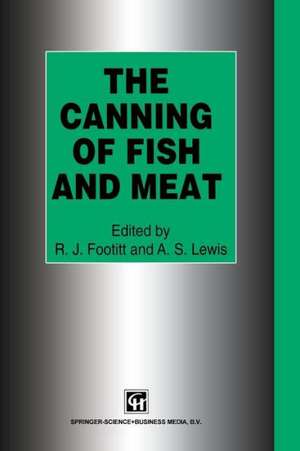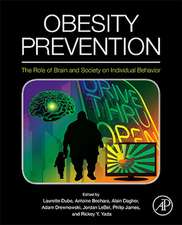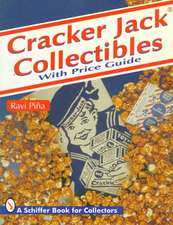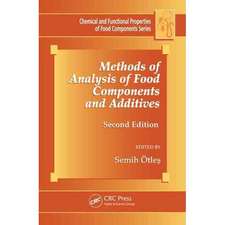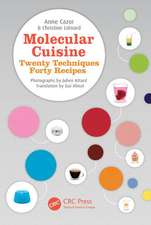The Canning of Fish and Meat
Editat de R. J. Footitten Limba Engleză Paperback – 20 oct 2012
Preț: 390.25 lei
Nou
Puncte Express: 585
Preț estimativ în valută:
74.67€ • 78.17$ • 61.79£
74.67€ • 78.17$ • 61.79£
Carte tipărită la comandă
Livrare economică 05-19 aprilie
Preluare comenzi: 021 569.72.76
Specificații
ISBN-13: 9781461358800
ISBN-10: 1461358809
Pagini: 332
Ilustrații: XV, 310 p.
Dimensiuni: 155 x 235 x 17 mm
Greutate: 0.47 kg
Ediția:Softcover reprint of the original 1st ed. 1995
Editura: Springer Us
Colecția Springer
Locul publicării:New York, NY, United States
ISBN-10: 1461358809
Pagini: 332
Ilustrații: XV, 310 p.
Dimensiuni: 155 x 235 x 17 mm
Greutate: 0.47 kg
Ediția:Softcover reprint of the original 1st ed. 1995
Editura: Springer Us
Colecția Springer
Locul publicării:New York, NY, United States
Public țintă
ResearchCuprins
1 Raw material sourcing.- 1.1 Introduction.- 1.2 Supply of fish.- 1.3 Finding fish.- 1.4 Catching fish.- 1.5 By-catch.- 1.6 On-board handling of fish.- 1.7 Quality retention.- 1.8 Fishfarming.- 1.9 Conclusions.- References.- 2 Fish raw material.- 2.1 Introduction.- 2.2 Transportation.- 2.3 Reception and testing.- 2.4 Storage.- 2.5 Defrosting frozen fish.- 2.6 Fish preparation.- 2.7 Storing prepared fish.- 2.8 Chemical indicators of quality.- References and Bibliography.- Appendix: Sources of machinery.- 3 Meat raw materials.- 3.1 Introduction.- 3.2 Specifications and quality assurance.- 3.3 Sampling procedures.- 3.4 Identity of meat.- 3.5 Manufacturing quality factors.- 3.6 Physical condition of meat.- 3.7 Microbiology of meat raw materials.- 3.8 Summary.- References.- 4 Canning factory standards.- 4.1 Introduction.- 4.2 Factory environment.- 4.3 Factory structure.- 4.4 Production area.- 4.5 Factory layout.- 4.6 Services.- 4.7 Personal hygiene.- 4.8 Equipment.- Further reading.- 5 Cans and lids.- 5.1 Introduction.- 5.2 Metals used in can manufacture.- 5.3 Methods of container manufacture.- 5.4 Selection of a can-making route.- 5.5 Mechanical properties of containers and ends.- 5.6 Coatings.- 5.7 Functions of can lacquers/enamels.- 5.8 Methods of lacquer application.- 5.9 Container corrosion; theory and practice.- 6 Filling operations.- 6.1 Introduction.- 6.2 Hand filling.- 6.3 Mechanical filling - general considerations.- 6.4 Meat filling.- 6.5 Fish filling.- 6.6 Liquid fillers.- 6.7 Fillers for fish and meat products in sauce.- 6.8 Operational safety.- 6.9 Control of the filling operation.- Acknowledgement.- Manufacturers of filling machines.- 7 Can seaming.- 7.1 Introduction.- 7.2 Can seaming.- 7.3 Double seam acceptability.- 7.4 Target setting.- 7.5 Seamer maintenance procedures.- 7.6 Double seaming technology developments 171 Glossary of terms and definitions.- 8 Heat treatment.- 8.1 Introduction.- 8.2 Aims of the retorting process and commercial sterility.- 8.3 The requirements for a retorting system.- 8.4 The classification and selection of sterilising systems.- 8.5 Batch retorts.- 8.6 Continuous sterilisers.- 8.7 Instrumentation and control of sterilising systems.- 8.8 Establishment of thermal process.- 8.9 Procedures and records.- 8.10 Retort operation.- 8.11 Process audit reconciliation.- Suggested further reading.- Principal European suppliers of retorts and sterilisers.- 9 Warehousing and distribution.- 9.1 Recent trends.- 9.2 The storage problem.- 9.3 Brightstacking.- 9.4 Block-stacking.- 9.5 Semi-automated warehouse systems.- 9.6 Despatch.- 9.7 Pallets versus hand stow versus slipsheets.- 9.8 Electronic data interchange.- 9.9 Stock control.- 9.10 Third-party contracts.- 9.11 Performance measurement.- 9.12 Imports.- 9.13 Distribution and shipping.- 10 Laboratory services.- 10.1 Laboratory facilities.- 10.2 Analytical testing.- 10.3 Microbiological testing.- 10.4 Analyses recommended for cannery water and retort cooling water.- 10.5 Swab testing.- 10.6 Incubation tests.- 10.7 Sterility testing.- 10.8 Types of spoilage.- 10.9 Consumer illness complaints.- 10.10 Botulism.- 10.11 Staphylococcal poisoning.- Laboratory in-house quality assurance and accreditation.- Acknowledgement.- Reference.- to Quality Indicators.- 11 Cleaning.- ll.1 Introduction to cleaning in the fish canning industry.- 11.2 Introduction to cleaning in the meat industry.- Appendices 1-11.
